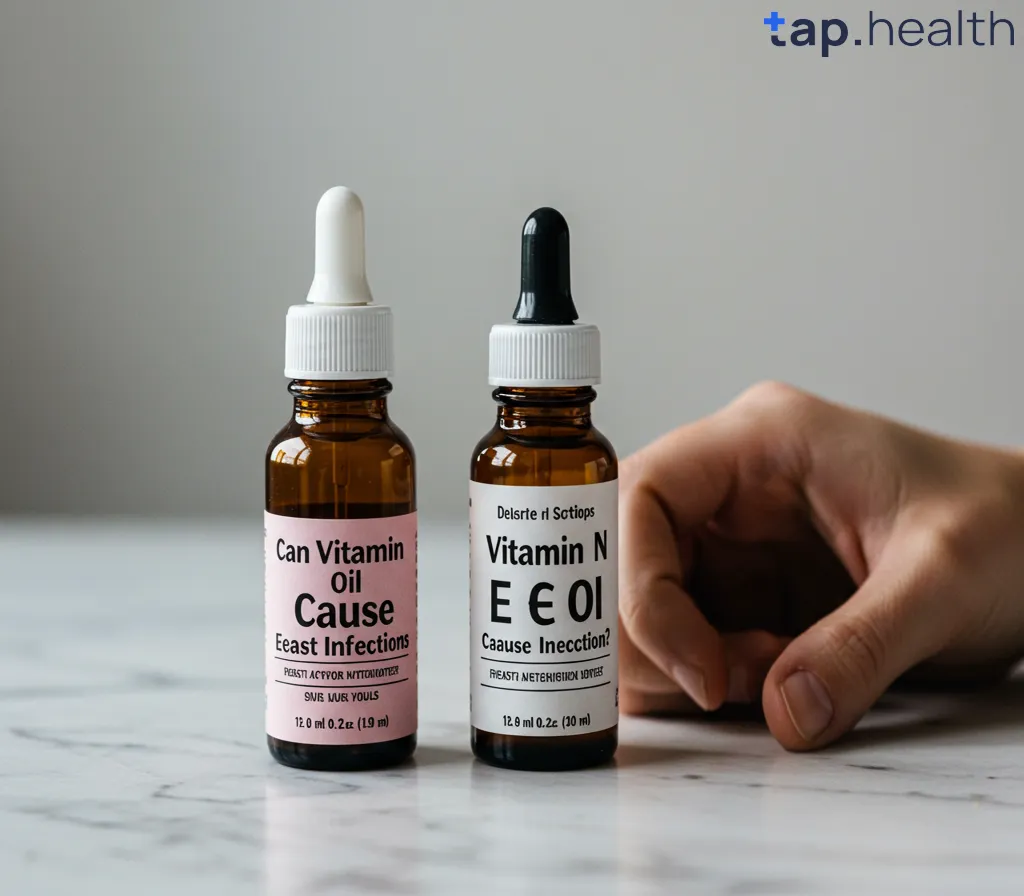You’ve probably heard that vitamin E is great for your skin. It’s in lotions, serums, and even natural remedies for dryness, scars, and stretch marks. Some people even use vitamin E oil to soothe irritation “down there.” But lately, a common question has been popping up: Can vitamin E oil cause yeast infections?
It’s a fair concern—especially if you’re dealing with vaginal discomfort and trying to figure out what’s making it worse.
The short answer? Vitamin E oil itself doesn’t directly cause yeast infections. But, under certain conditions, using it in or around the vagina might contribute to an environment where yeast can grow more easily.
In this article, we’ll break everything down in simple, easy-to-understand language. No confusing medical terms. No robotic tone. Just honest, science-backed facts from trusted health sources like the Mayo Clinic, CDC, and NIH.
We’ll cover:
- What yeast infections are and what causes them
- How vitamin E oil works on the skin
- Whether it’s safe to use near the vagina
- If it can disrupt your natural pH or moisture balance
- Safe ways to use vitamin E oil
- Common myths and misunderstandings
- And much more
Let’s get clear on this once and for all.
What Is a Yeast Infection?
A yeast infection (also called vaginal candidiasis) happens when there’s too much of a fungus called Candida—usually Candida albicans—in the vagina.
This fungus normally lives in small amounts in your vagina, mouth, and digestive tract without causing problems. But when it grows out of control, it leads to symptoms like:
- Itching and burning
- Thick, white, odorless discharge (like cottage cheese)
- Redness and swelling
- Pain during sex or when peeing
Yeast infections are super common. In fact, about 75% of women will have at least one in their lifetime, and many will have repeat infections.
But here’s the thing: yeast doesn’t just show up out of nowhere. It grows when the natural balance in your body gets thrown off.
What Causes Yeast Infections?
Several things can trigger yeast overgrowth. The most common include:
Antibiotics
They kill harmful bacteria, but also the good ones that keep yeast in check.
Hormonal changes
Pregnancy, birth control pills, and hormone therapy can change your vaginal environment.
High blood sugar
Especially in people with uncontrolled diabetes—yeast loves sugar.
A weakened immune system
From stress, illness, or conditions like HIV.
Tight or damp clothing
Moist, warm areas are perfect for yeast to grow.
Scented hygiene products
Douches, sprays, and perfumed soaps can irritate the vagina and disrupt its pH.
Now, where does vitamin E oil fit into all of this? Let’s take a closer look.
What Is Vitamin E Oil?
Vitamin E is a fat-soluble vitamin that acts as an antioxidant. It helps protect your cells from damage and supports healthy skin and immune function.
Vitamin E oil is a concentrated form often used topically (on the skin). You can buy it in liquid form, capsules (puncture and squeeze), or as an ingredient in creams and lotions.
People use it for:
- Moisturizing dry skin
- Healing scars and stretch marks
- Soothing chapped lips
- Reducing inflammation
- Treating minor cuts or burns
It’s generally safe and well-tolerated on most skin types. But just because it’s natural doesn’t mean it’s safe for every part of the body—especially sensitive areas.
Can Vitamin E Oil Cause Yeast Infections?
Here’s the bottom line: No, vitamin E oil does not directly cause yeast infections.
There is no scientific evidence that vitamin E oil introduces yeast or makes Candida grow on its own.
However—and this is important—using oil-based products near or inside the vagina can create conditions that favor yeast growth.
Let’s explain why.
Why Oils Might Increase the Risk of Yeast Infections
The vagina has a delicate balance of good bacteria (like Lactobacillus) and a slightly acidic pH (around 3.8 to 4.5). This environment keeps yeast and other harmful microbes under control.
When you introduce oil-based products—like vitamin E oil, coconut oil, or even petroleum jelly—several things can happen:
1. Oils Trap Moisture
Oils are not water-soluble. That means they don’t wash away easily and can trap moisture in the vaginal area. Yeast thrives in warm, moist environments.
2. Oils Can Disrupt pH
While vitamin E oil isn’t highly acidic or alkaline, adding any foreign substance can temporarily alter the vaginal pH, making it easier for yeast to multiply.
3. Oils May Irritate Sensitive Skin
Some people are sensitive to oils or additives in vitamin E products. Irritation can lead to micro-tears or inflammation, which may make the area more vulnerable to infection.
4. Oils Can Degrade Latex
If you’re using condoms, oil-based products (including vitamin E oil) can weaken latex and increase the risk of breakage. This doesn’t cause yeast infections, but it can lead to other complications.
So, while vitamin E oil isn’t a direct cause, it can be a contributing factor—especially if used improperly.
Is It Safe to Use Vitamin E Oil on the Vulva?
Yes, it’s generally safe to use vitamin E oil on the vulva—the outside part of your genitals.
The vulva includes the labia (lips), clitoris, and opening to the vagina. This skin can get dry, itchy, or irritated, especially during:
- Menopause
- Breastfeeding
- After shaving or waxing
- During certain skin conditions (like eczema)
Vitamin E oil can help moisturize and soothe these areas.
Tips for safe use:
- Use a small amount
- Do a patch test first (apply on your arm to check for reactions)
- Choose pure, additive-free vitamin E oil
- Avoid getting it inside the vagina
If you notice redness, burning, or increased itching, stop using it.
Should You Put Vitamin E Oil Inside the Vagina?
No. It’s not recommended to insert vitamin E oil into the vagina.
Here’s why:
The Vagina Cleans Itself
Your vagina has a self-cleaning system. It produces discharge to flush out dead cells and bacteria. You don’t need to (and shouldn’t) put oils, creams, or douches inside.
Oils Can’t Be Washed Out Easily
Unlike water-based products, oils don’t dissolve in vaginal fluids. They can linger and create a breeding ground for bacteria or yeast.
Risk of Disrupting Good Bacteria
The good bacteria in your vagina (especially Lactobacillus) help maintain acidity and prevent infections. Introducing oils may interfere with this balance.
No Proven Benefits
There’s no medical evidence that putting vitamin E oil inside the vagina helps with dryness, healing, or infections. In fact, the American College of Obstetricians and Gynecologists (ACOG) advises against using oils or petroleum-based products internally.
For vaginal dryness, doctors recommend:
- Water-based or silicone-based lubricants
- Vaginal moisturizers (like Replens)
- Prescription estrogen creams (if due to menopause)
These are safer and more effective than vitamin E oil.
Can Vitamin E Oil Be Used for Vaginal Dryness?
While some people turn to vitamin E oil for vaginal dryness, it’s not the best choice—especially for internal use.
Vaginal dryness is common during:
- Menopause
- Breastfeeding
- Stress
- Certain medications (like antihistamines or birth control)
But using oil-based products like vitamin E can do more harm than good.
Better alternatives:
- Water-based lubricants – Safe for use with condoms and won’t disrupt pH
- Silicone-based lubricants – Long-lasting, but don’t use with silicone toys
- Vaginal moisturizers – Used regularly to maintain moisture (not just during sex)
- Prescription treatments – Like low-dose estrogen creams, if recommended by a doctor
If you’re experiencing persistent dryness, talk to your healthcare provider. Don’t self-treat with oils that could increase infection risk.
What About Vitamin E Capsules? Are They Safe?
Some people puncture vitamin E capsules and apply the oil directly to the skin—or even insert them vaginally.
Applying the oil externally (on the vulva) is generally safe if you’re not allergic and use it sparingly.
Inserting capsules into the vagina is not safe or recommended.
There’s no scientific proof that it helps with infections, dryness, or healing. In fact, the Mayo Clinic and other health experts warn against putting any non-sterile substances into the vagina.
Doing so can:
- Irritate the lining
- Disrupt natural flora
- Increase the risk of infection
- Cause allergic reactions
Stick to products designed for intimate use.
Are There Any Benefits of Vitamin E for Vaginal Health?
While vitamin E oil shouldn’t be used inside the vagina, the vitamin itself plays a role in overall reproductive and skin health.
Antioxidant Protection
Vitamin E helps protect cells from oxidative stress, which may support healthy vaginal tissue.
Skin Healing
Topical vitamin E can help heal minor cuts, tears, or irritation on the external skin.
Menopausal Support
Some studies suggest that vitamin E supplements may help reduce mild vaginal dryness and discomfort in menopausal women—but the effect is small, and topical application is not proven to help.
Important: Getting vitamin E from food (like nuts, seeds, spinach, and vegetable oils) is safe and beneficial. Topical use on the vulva is okay. Internal use of oil is not.
Can Vitamin E Oil Treat Yeast Infections?
No. Vitamin E oil is not a treatment for yeast infections.
Yeast infections need antifungal medicine to clear them. Common treatments include:
- Over-the-counter creams (like miconazole or clotrimazole)
- Oral medication (like fluconazole)
- Prescription suppositories
Using vitamin E oil instead of proper treatment can delay healing and make symptoms worse.
Also, some people mistakenly think that because vitamin E is “natural,” it must be safe and effective. But natural doesn’t always mean safe for every use.
If you suspect a yeast infection, see a doctor or use a trusted antifungal product. Don’t rely on oils or home remedies without evidence.
What Are Safer Alternatives to Vitamin E Oil for Intimate Care?
If you’re looking for ways to soothe, moisturize, or protect your intimate area, here are safer options:
1. Water-Based Lubricants
- Safe for condoms
- Easy to wash off
- Less likely to cause irritation
- Examples: Sliquid, KY Jelly (fragrance-free)
2. Vaginal Moisturizers
- Designed to restore moisture over time
- Used every few days, not just during sex
- Examples: Replens, Vagisan
3. Coconut Oil (With Caution)
- Some people use organic, unrefined coconut oil externally
- Has mild antifungal properties
- But: It’s still an oil—don’t use internally or with latex condoms
- Patch test first
4. Aloe Vera Gel (Pure)
- Soothes irritation and redness
- Use only 100% pure aloe, no added alcohol or fragrances
- Apply externally only
5. Cotton Underwear and Loose Clothing
- Helps keep the area dry and breathable
- Reduces moisture buildup
Can Other Oils Cause Yeast Infections?
Yes, any oil-based product used in or around the vagina has the potential to contribute to yeast overgrowth—not just vitamin E oil.
Common ones include:
- Coconut oil
- Olive oil
- Almond oil
- Baby oil
- Petroleum jelly (Vaseline)
While some oils (like coconut oil) have antifungal properties, they can still trap moisture and disrupt pH when used improperly.
Rule of thumb: If it’s oil-based, don’t use it inside the vagina or as a daily moisturizer in the genital area.
How to Prevent Yeast Infections
The best way to avoid yeast infections is to support your body’s natural balance. Here are proven tips:
Wear Breathable Underwear
Cotton underwear allows airflow and reduces moisture. Avoid tight synthetic fabrics like nylon or polyester.
Change Out of Wet Clothes Quickly
Don’t stay in sweaty gym clothes or wet swimsuits for long. Change as soon as possible.
Avoid Douching
Your vagina doesn’t need to be “cleaned” with sprays or douches. They disrupt good bacteria and increase infection risk.
Use Mild, Unscented Soaps
Fragranced soaps, bubble baths, and feminine washes can irritate the vulva and vagina.
Wipe Front to Back
This prevents bacteria from the anus (like E. coli) from entering the vagina.
Manage Blood Sugar
If you have diabetes, keeping your blood sugar under control reduces yeast infection risk.
Take Probiotics
Some studies suggest that probiotics (especially Lactobacillus strains) may help maintain healthy vaginal flora and prevent recurrent infections.
When to See a Doctor
See a healthcare provider if:
- You’re unsure if it’s a yeast infection or something else (like bacterial vaginosis or an STI)
- Symptoms don’t improve after using OTC treatment
- You have frequent infections (4 or more per year)
- You’re pregnant
- You have severe pain, fever, or unusual discharge
Never ignore persistent symptoms. Some conditions mimic yeast infections but need different treatments.
Can Vitamin E Oil Cause Other Types of Infections?
While yeast infections are the main concern, vitamin E oil could potentially contribute to other issues if used improperly:
Bacterial Vaginosis (BV)
BV happens when harmful bacteria outnumber good ones in the vagina. Like yeast infections, it can be triggered by products that disrupt pH or moisture balance. Oils may contribute to this imbalance.
Skin Infections
If you apply vitamin E oil to broken or irritated skin, and the product isn’t clean, it could introduce bacteria and lead to a minor skin infection.
Always:
- Wash your hands before applying
- Use clean applicators
- Don’t share products
Allergic Reactions
Some people are allergic to vitamin E or the carrier oils in supplements. Signs include:
- Redness
- Swelling
- Hives
- Itching
Stop use immediately if you notice these.
Is Vitamin E Oil Safe During Pregnancy?
Topical use of vitamin E oil on the skin (like your belly) is generally safe during pregnancy and often used to prevent stretch marks.
However:
- Do not use it internally during pregnancy
- Avoid applying large amounts to sensitive areas
- Talk to your doctor before using any new product
Pregnancy increases the risk of yeast infections due to hormonal changes, so it’s best to avoid anything that could add to that risk.
What Do Doctors Say About Vitamin E Oil and Yeast Infections?
Major health organizations agree:
- Mayo Clinic: Advises against using oils or petroleum jelly in the vagina due to infection risk.
- CDC: Recommends avoiding douches and scented products; doesn’t mention vitamin E oil but supports pH balance.
- ACOG (American College of Obstetricians and Gynecologists): Warns against inserting oils, herbs, or home remedies into the vagina.
- NIH: States that vitamin E has no proven role in treating or preventing vaginal infections.
In short: doctors support using vitamin E for skin health—but not as a vaginal treatment.
Final Thoughts: Can Vitamin E Oil Cause Yeast Infections?
Let’s recap:
✅ Vitamin E oil does NOT directly cause yeast infections.
⚠️ But using it near or inside the vagina may create conditions where yeast can grow.
🚫 It should NOT be inserted into the vagina.
✅ It’s safe to use on the vulva (external area) in small amounts.
🧴 Safer alternatives exist for vaginal dryness and irritation.
The key is knowing the difference between external and internal use.
Your vagina is self-cleaning and self-balancing. It doesn’t need oils, creams, or DIY remedies. In fact, those can do more harm than good.
If you’re dealing with dryness, itching, or infections, talk to a doctor. There are safe, effective treatments available.
And if you love using vitamin E oil for your skin—go ahead! Just keep it where it belongs: on your arms, legs, face, or belly… not inside your body.
Frequently Asked Questions (FAQ)
Can vitamin E oil cause yeast infections?
No, vitamin E oil does not directly cause yeast infections. However, using it in or around the vagina may trap moisture and disrupt pH, which can contribute to yeast overgrowth.
Is it safe to use vitamin E oil on the vulva?
Yes, it’s generally safe to use small amounts of vitamin E oil on the external genital area (vulva) to soothe dryness or irritation. Avoid getting it inside the vagina.
Can I put vitamin E capsules in my vagina?
No. Inserting vitamin E capsules or oil into the vagina is not recommended. It can disrupt natural bacteria, trap moisture, and increase the risk of infection.
Does vitamin E help with vaginal dryness?
There’s no strong evidence that vitamin E oil helps with internal vaginal dryness. For relief, use water-based lubricants or vaginal moisturizers recommended by doctors.
What oils are safe to use near the vagina?
Stick to water-based or silicone-based products for internal use. For external use, pure coconut oil or aloe vera may be safe, but patch test first and avoid internal application.
Can vitamin E oil treat a yeast infection?
No. Yeast infections require antifungal medication (like creams or pills). Vitamin E oil is not a treatment and may worsen symptoms if used improperly.
Why are oils bad for the vagina?
Oils are not water-soluble, so they don’t wash away easily. They can trap moisture, disrupt pH, and interfere with good bacteria—creating a perfect environment for yeast.
Can vitamin E cause itching or irritation?
Yes, some people may be allergic or sensitive to vitamin E or the oils used in supplements. This can cause redness, itching, or swelling, especially on sensitive skin.
Is vitamin E good for vaginal health?
The vitamin itself supports skin and cell health, but applying the oil internally is not beneficial. Focus on diet, hygiene, and doctor-approved treatments for vaginal health.
Can I use vitamin E oil after shaving the bikini area?
Yes, in small amounts. It can help soothe irritation and moisturize the skin after shaving. Just don’t apply it inside the vagina.
Does vitamin E oil kill yeast?
No. Vitamin E has antioxidant properties but does not have antifungal effects strong enough to kill Candida or treat infections.
Can I use vitamin E oil with condoms?
No. Oil-based products (including vitamin E oil) can weaken latex condoms and cause them to break. Use water-based or silicone-based lubricants instead.
How can I safely moisturize my vaginal area?
Use a vaginal moisturizer (like Replens) or water-based lubricant. Wear cotton underwear, avoid scented products, and keep the area dry and clean.
Are there any natural remedies for yeast infections?
Some people try yogurt, probiotics, or garlic, but evidence is limited. The safest and most effective treatment is antifungal medication. Always consult a doctor before trying home remedies.
Can vitamin E supplements cause yeast infections?
No. Taking vitamin E pills orally does not cause yeast infections. The concern is only with topical or internal use of the oil form.
What should I do if I used vitamin E oil and now have symptoms?
Stop using it. Wash the area with water and mild soap. If symptoms like itching, discharge, or burning persist, see a doctor for proper diagnosis and treatment.
Understanding your body and using products wisely is the best way to stay healthy. When in doubt, ask a healthcare professional—your vagina will thank you.



